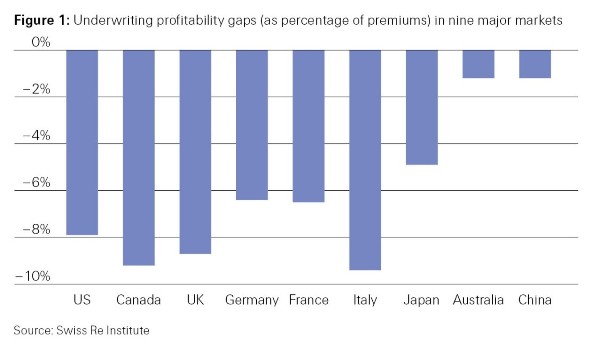Swiss Re Sigma: Insurance Premium Rate Increases Will Be Needed

September 11, 2018

Swiss Re said that worldwide, most major non-life insurance markets are in a phase of below-average profitability. The latest Swiss Re Institute sigma report, titled "Profitability in non-life insurance: mind the gap," assesses the existing earnings gap in the non-life insurance sector. According to Swiss Re, the analysis shows that insurers in major western markets and Japan need to improve underwriting margins (underwriting profit as a percentage of premiums) by around 5 to 9 percentage points in order to achieve a desired return on equity (ROE) of 10 percent in the future.
Current economic momentum will benefit future profitability through higher interest rates and investment returns, but it won't be enough to close the gaps, according to the reinsurer. At the same time, tighter labor markets are expected to push up wage and claims inflation. Thus, premium rates need to increase more than claims trends to achieve sustainable improvement in profitability, said Swiss Re.
The reinsurer said that the global non-life insurance sector is at a weak phase of the profitability cycle, reflecting soft underwriting conditions, weak investment performance, and the high level of capital funds. Swiss Re said sector ROE slipped further to 6 percent last year, from 7 percent in 2016 and the roughly 9 percent achieved annually between 2013 and 2015.
2017 Catastrophe Season May Have Triggered an Inflection Point
Swiss Re said that while underwriting conditions are still soft in 2018, particularly in commercial insurance, they seem to be passing through an inflection point. The reinsurer said this is on account of the large hurricane losses in 2017, which set the stage for a price correction. Commercial line premium rates started to rise at the end of 2017.
"The catastrophe losses in 2017 sparked a modest change in market dynamics," says Edouard Schmid, Swiss Re group chief underwriting officer. "However, it remains to be seen how strong and sustainable the market firming is. Rate increases for accounts and commercial lines of business not affected by the catastrophe losses, for instance, have been below initial expectations." In personal lines, there has been moderate rate hardening in several key markets for a few years already.
Premium Rates Need To Increase Substantially To Restore Profitability
Despite the modest premium rate hardening, the sigma shows that more work to improve underwriting performance needs to be done if current shortfalls in profitability are to be redressed. The study found that underwriting margins need to improve by around 5 to 9 percentage points in major western markets and Japan to deliver the desired ROE of 10 percent to investors.

Economic Developments Alone Will Not Close the Profitability Gap
Interest rates and non-life insurers' underwriting results are interrelated in the long run, according to Swiss Re. In the past, during periods of higher interest rates, stronger investment returns were offset by larger underwriting losses. By contrast, in the current cycle, underwriting results have deteriorated without the benefit of compensating rising yields, as the slow post-crisis recovery has led to a prolonged backdrop of low interest rates, said the reinsurer.
Underlying economic growth improved strongly in 2017, and this is expected to continue in 2018, putting upward pressure on inflation and interest rates. Central banks in many countries are already withdrawing monetary stimulus to ward off overheating. This signals a changing operating environment for non-life insurers, said Swiss Re.
"Under the current stronger economic conditions, we expect interest rates in mature markets to continue to rise moderately, which should support insurers' earnings through higher investment returns," says Jérôme Jean Haegeli, group chief economist at Swiss Re. However, "macroeconomic developments alone are unlikely to generate sustained improvement in non-life sector profitability. The trend of declining investment yields has bottomed, but at the same time, the increase in long-term interest rates that we foresee is not substantial."
Moreover, the reinsurer said tighter labor markets are projected to push up general and claims inflation, creating an offsetting effect on profitability. The accelerating claims inflation will have the added impact of eroding the adequacy of claims reserves and further affirms that, in order to achieve sustainable improvement in sector profitability, insurance premium rate increases in excess of rising claims trends will be needed.
Long-run Performance in Line with Other Industries
In its analysis of the profitability cycle, this sigma shows that over the long run, insurance companies have delivered a level of profitability comparable with firms in other sectors. In line with these profit trends, a 2-decade comparison of non-life insurers' stock market performance suggests on-par or even above-par valuation.
Furthermore, insurance stocks demonstrate low correlation of price returns with other industry sectors and thus offer value to investors in the form of diversification benefits.
Swiss Re said underlying trends indicate that underwriting cycles are strongly integrated globally and across lines of business. The analysis in the sigma identifies a general cyclical pattern but also some idiosyncratic variations due to natural catastrophe losses and a degree of country- and line-specific pricing trends.
Hence, writing non-life business across lines and countries brings diversification benefits to an insurer's underwriting portfolio, said the reinsurer. Another finding is that the average duration of the cycle seems to have lengthened since the early 1980s, when central banks changed their policy focus toward fighting inflation and large parts of the financial services industry were deregulated.
Investments in Technology Benefit Efficiency and Insurability
The pressure on non-life earnings has heightened interest in innovation, said Swiss Re. Insurers' investments in technology have led to efficiency gains and compressed margins for the distribution system in commoditized lines.
In some lines of business, the adoption of technology has also reduced claims costs. The benefits to profitability are initially clouded by the gains being partially passed on to consumers through competition and also by the cost of investment in technology, according to the reinsurer.
Over the long run, investments in data and advanced analytics improve efficiency, underwriting, and the insurability of increasingly complex risks, be it through improved affordability, access, or better ability to underwrite new and hard-to-quantify risks, said Swiss Re.
The sigma No 4/2018, "Profitability in non-life insurance: mind the gap," is available electronically on the Swiss Re Institute's website.
September 11, 2018







